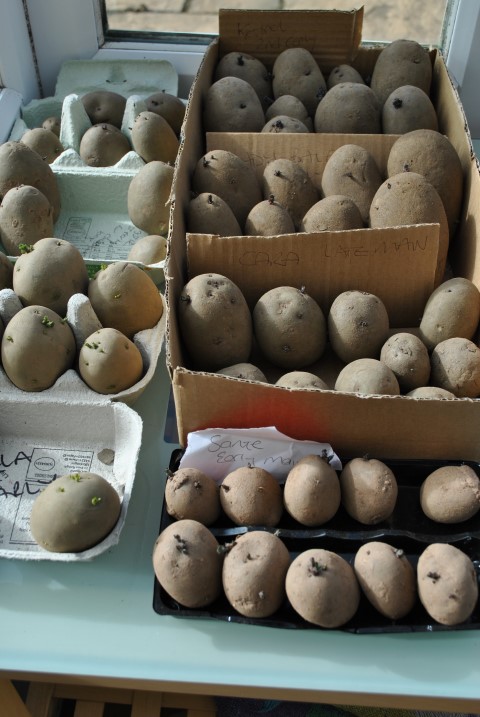Last year my spuds were a tad disappointing. Yes, we harvested enough to scatter around a few meals, but not the bumper crops we were hoping for.
This year I’m hedging my bets and am planting a whopping SIX varieties. I figure that with all that selection, there must be at least one that will do well in my garden.
Seed potatoes are available in garden centres and via the internet now, but I ordered mine online last year. I went for a collection called ‘Allotment favourites’, as this seemed to offer an array of potatoes that would crop throughout the year, were fairly resistant to blight and other critters, and most importantly, had received good reviews from more experienced gardeners and allotment keepers. What could possibly go wrong?
So, a couple of weeks ago, the parcel was duly delivered, and I could hardly contain my excitement as I ripped open the packaging. Sure enough, nestled inside the box were six bags of potatoes.
The spuds I’m giving a bash this year are:
- First earlies – Orla and Lady Christl
- Second earlies – Kestrel
- Early main -Balfour and Sante
- Late main – Cara
Earlies are normally new potatoes, whilst the main crops tend to be bigger varieties used for jackets and roasting etc.
Before any of them can be planted out though, they will need to have first thrown up a couple of nodules, or ‘chits’. The entire collection of spuds is therefore camping out in my conservatory to do just this – it’s light, dry and cool in there, so should be the perfect chitting conditions.
If you look at your seed potato, you’ll notice that one end has just one mark on it; the other end has a few more (called the rose end). Place the potatoes ‘one end’ down, ‘rose end’ up in egg boxes or crates – the chits will start to pop out from the top. These tiny shoots will help the potatoes get established more quickly once they are in the soil.
I’ve also made an extra effort to label them all clearly. With six varieties to be harvested at four different times of the year, I’m leaving nothing to chance. In the past, I’ve found to my dismay that once they are all muddled up, it’s nigh on impossible to sort them out… they just look like spuds to me.
Apparently all the varieties can start to be planted out during March. They’ll go in the bed that had roots and onions in last year, which I’ve started to dig over in preparation. Lady Cristl is suited to growing in containers and potato bags, so I’ll be trying out some in tyres and some in the old recycling bag that our cardboard used to be collected in.
A quick inspection of the potatoes in the conservatory confirms that little shoots are indeed beginning to form (I chit you not), so I think a planting job may well be on the cards sometime soon. I’m aiming for nothing less than a spud mountain this year…
Hinckley Times 7 March 2013







